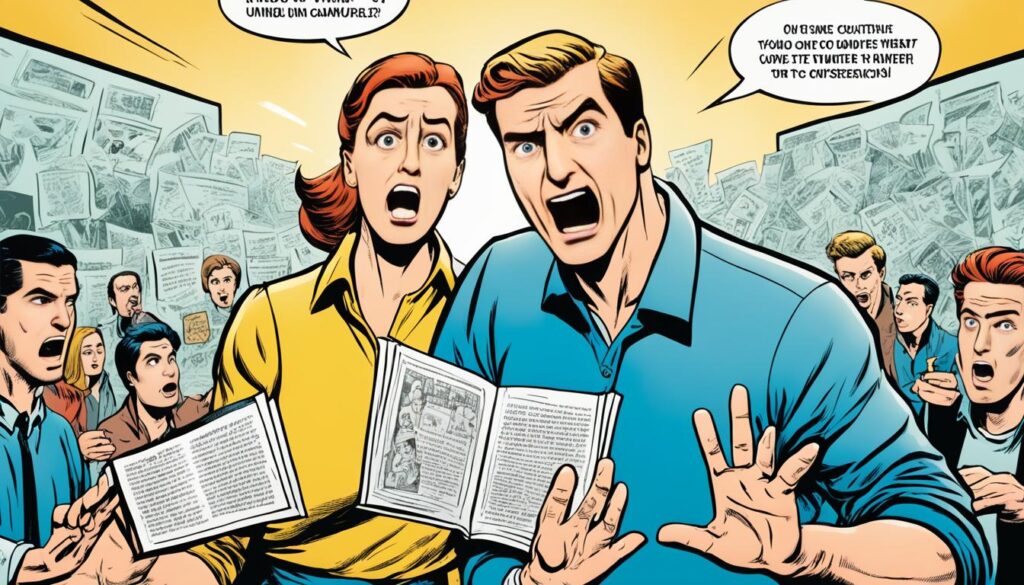Today’s global business world demands a deep understanding of cultural differences. As companies grow globally, they meet a diverse group of people. The way these different cultures communicate and solve problems can affect the whole organization.
Consider Lisa and Ahmed working together. Lisa speaks directly because of her culture. Ahmed, from a different background, uses more indirect methods. If they don’t understand their differences, miscommunication can happen. This can lead to less work getting done.
Key Takeaways:
- Cultural differences shape how we talk, make decisions, solve conflicts, and our daily work life.
- Training helps employees understand each other’s cultural backgrounds.
- Open talks and feedback help fix misunderstandings quickly.
- Groups that promote inclusivity make everyone feel they belong.
- Global leaders must adjust their leadership and motivation methods to fit diverse teams.
To overcome cultural gaps, taking early action helps. Training programs teach workers about cultural differences. This makes it easier for everyone to get along. Having clear communication and feedback spots problems early.
Initiatives that promote being inclusive are vital. They make sure everyone feels part of the team. It’s important in big companies with people from different places.
Leaders must be flexible in their approach. They should understand and respect the varied backgrounds of their team. This helps in creating a supportive and effective work environment.
Creating a common company culture that respects diversity is key. It helps in bringing everyone together. Leveraging cultural diversity is essential. It is a necessary skill in our globalized world, not just something nice to have.
Next, we will look at ways to handle cultural differences effectively. We’ll examine cultural dimensions and how to deal with language issues. We’ll explore business etiquette, how to negotiate across cultures, and use cultural differences as strengths. Lastly, we’ll discuss the role of intercultural skills in international business law education.
The Challenge of Cultural Diversity
Cultural differences impact the corporate world greatly. They influence communication, decision-making, and workday norms. Every day, companies face the challenge and reward of cultural diversity.
Diverse companies often outperform others financially. They also keep their employees longer and save money on turnover.
Having a range of cultures at work boosts respect among colleagues. This leads to loyalty and a more productive workplace. Teams work better together, valuing everyone’s unique input.
Diverse teams are more productive and better at solving problems. They bring different views and knowledge. This helps them find new solutions to challenges.
Cultural diversity demands critical thinking, creativity, and flexibility. By embracing it, companies support their employees’ growth. This contributes to better achievements.
Diversity lets companies offer a wider range of products and services. They better understand different customers’ needs. This makes them more competitive and profitable.
Understanding different cultures helps in creating better marketing. A varied workforce avoids big marketing mistakes. It also connects better with customers.
In the end, cultural diversity in the workplace offers both challenges and rewards. By valuing differences, organizations tap into the power of diversity. This leads to better innovation and success.
Strategies for Managing Cultural Differences
To handle cultural differences well, companies must support cultural awareness and sensitivity. By creating an inclusive and open environment, they make everyone feel accepted. Leaders should adapt to diverse teams to build a unified company culture. Here are strategies for managing cultural differences:
Promote Cultural Awareness and Sensitivity
At the company’s heart should be cultural awareness and sensitivity. By offering education and training, companies help employees understand various cultures. This understanding promotes respect and empathy in interactions with others.
Develop Cross-cultural Communication Skills
Good communication across cultures is crucial for teamwork. Workshops should teach employees to listen well, read non-verbal cues, and adapt their talking styles. These skills help in working together smoothly.
Promote Open Communication Channels
It’s essential to have open channels for communication in the workplace. Employees need to feel safe sharing their thoughts. Having regular feedback helps keep the conversation going and improves the company.
Foster Inclusivity and Belonging
Actions that encourage inclusivity help everyone feel part of the team. Groups like employee resource groups give a space to share and celebrate different cultures. This makes the workplace more welcoming for all.
Adapt Leadership and Management Styles
Leaders should adjust how they manage to suit diverse teams. This includes valuing different cultures, supporting religious practices, and considering diverse schedules. Embracing diversity brings new ideas and solutions.
Create a Shared Corporate Culture
While valuing diversity, it’s important to have a common company culture. This culture helps unite employees towards shared goals. The company should clearly state what behaviors are expected, not tolerating any form of discrimination.

By following these strategies, companies can manage cultural differences well. They create a place where everyone is welcome and can thrive. Businesses focused on cultural understanding and inclusivity often do better and are more innovative.
Understanding Cultural Dimensions
When we talk about cultural differences globally, knowing about cultural dimensions is key. These dimensions help us see how cultures vary. They show us differences in values, attitudes, and behaviors across the world.
Geert Hofstede’s model is a great tool for learning about cultural dimensions. Hofstede was a Dutch researcher who identified six key dimensions. These dimensions help us understand the variety in cultural norms and actions.
- Power Distance: This dimension looks at how societies deal with power inequality. High power-distance cultures have strict hierarchies and formal ways of talking. On the other hand, low power-distance cultures value equality and casual communication.
- Individualism vs. Collectivism: Here, the focus is on whether people think more about themselves or the group. Individualistic cultures cherish personal freedom and goals. Collectivist cultures value group unity and agreement in their talks.
- Masculinity vs. Femininity: In masculine cultures, competition and success are important. Feminine cultures, however, value cooperation and the well-being of people.
- Uncertainty Avoidance: This dimension measures how cultures handle uncertainty. High uncertainty avoidance cultures want stability and clear guidelines. Cultures with low uncertainty avoidance are okay with change and unclear situations.
- Long-Term vs. Short-Term Orientation: Cultures with a long-term view focus on future goals and patience. Short-term oriented cultures look for quick results and maintaining social ties.
- Indulgence vs. Restraint: Indulgent cultures seek freedom in expressing joy and values. Restrained cultures stress on self-discipline and following social rules.
By getting to know these cultural dimensions, we can treat people from different backgrounds with more respect. This knowledge helps avoid misunderstandings and improves communication.
Hofstede’s framework guides us on how societies work. It helps people adjust when talking to others from different cultures. Programs on intercultural management prepare us to interact better. This leads to stronger teams and successful cooperation.
Remember, cultural dimensions are complex. We shouldn’t use them to stereotype. Everyone is unique. These dimensions offer a general insight but recognize personal differences.

Grasping cultural dimensions is vital for better communication across cultures. It helps us empathize and connect with people from varied backgrounds.
Overcoming Language Barriers
Language barriers can make it hard to work well in teams from different cultures. These barriers come from not sharing the same native language, using different dialects, and even interpreting words differently. At Nulab, with a mix of Japanese and English speakers, overcoming these barriers is key for teamwork.
To solve this issue, using translators and interpreters helps a lot. They are vital in helping people who speak different languages understand each other. This ensures that everyone gets the message clearly.
But overcoming language barriers isn’t just about talking. Non-verbal cues and cultural differences in communication matter too. Things like eye contact and body language can cause misunderstandings. It’s important to be aware of these differences to communicate well.
Technical languages and jargon can also create barriers. At Nulab, the development team needs to share complex ideas in simple terms. This helps everyone understand each other better, even if they’re not experts.
Disabilities like stuttering or hearing loss add to the challenge of verbal communication. These don’t stop someone from understanding or working well. But they may need different ways to communicate.
New employees often find company-specific terms hard to understand. Nulab offers English classes in Japan to help bridge this gap. This makes it easier for everyone to work together.
Visual aids are another great way to overcome language barriers. Diagrams and pictures can explain complicated ideas better than words. This helps improve understanding in diverse teams.
Strategies to Overcome Language Barriers
| Strategies | Description |
|---|---|
| Utilize interpreters and translators | Professional language experts facilitate communication between individuals who speak different languages. |
| Be mindful of non-verbal communication | Cultural differences in eye contact, gestures, and personal space can impact the effectiveness of communication. |
| Use simple language and avoid jargon | Make communication understandable and accessible to individuals with various language proficiencies. |
| Accommodate language disabilities | Provide alternative methods of communication or assistive devices to facilitate effective interactions for individuals with language disabilities. |
| Offer language classes | Providing language training to employees can enhance communication and understanding between different language-speaking teams. |
| Employ visual methods of communication | Utilize diagrams and visuals to convey complex ideas and foster better understanding in diverse teams. |
Overcoming language barriers needs patience and respect. It’s important to be ready to clear up any confusion. Sharing information more than once is often needed to make sure everyone understands.
Paying attention to language barriers helps create a welcoming and effective workplace. It supports diversity and helps businesses succeed on a global scale.

Cultural Etiquette in Business
Understanding cultural etiquette is crucial when doing business internationally. Cultural norms strongly influence business interactions, from how people greet each other to meeting customs. By showing respect for these customs, you can build strong connections and achieve long-term success.
Every culture has unique greetings. Some countries prefer handshakes, while others might choose hugs or air kisses. Knowing the right greeting for your business partner’s culture is important.
Meeting customs also differ widely across cultures. In some places, bringing a gift is key to building business relationships. Knowing what gifts to bring and the proper way to present them can create goodwill. Some cultures have special seating arrangements or ways to address those in higher positions.
Being on time varies in importance across cultures. Some value punctuality highly, while others are more flexible. By understanding and adapting to these time views, you can work together better.
Clear communication is essential in cross-cultural business. It’s important to consider language barriers and aim for clear understanding. Building trust and rapport means listening well and respecting different ways of communicating.
To master business across cultures, you need to be open and genuinely interested. Showing that you understand and respect cultural differences helps avoid misunderstandings or errors.
As globalization grows, so does cross-cultural business communication. Being culturally competent gives businesses an edge. It opens up new opportunities, improves negotiations, and enhances their global reputation.
In summary, cultural etiquette is vital in global business. Understanding and respecting cultural norms helps in building strong connections. It makes communication more effective and helps navigate business challenges across cultures.

Key Takeaways:
- Cross-cultural business etiquette is crucial for building strong relationships in international business settings.
- Demonstrating cultural sensitivity and adapting to customs can lead to fruitful collaborations and long-term business relationships.
- Understanding the cultural context before engaging in business interactions is essential.
- Effective communication is vital for successful cross-cultural business interactions.
- Gift-giving is an important aspect of business relationships in many cultures.
- Seek local guidance and build relationships to navigate cross-cultural business etiquette effectively.
- Mastering cross-cultural business etiquette requires cultural sensitivity, an open mind, and genuine interest.
Negotiating Across Cultures
Negotiating across cultures comes with its own set of challenges. Differences in priorities, communication, and cultural norms need attention. You need to adapt and understand these differences to succeed.
Cultural norms shape negotiations significantly. In a survey involving 7,000 people across 30 countries, findings showed how tight or loose these norms are. Countries like Japan and Turkey have strict rules about time and behaviour. Meanwhile, places like the USA and Brazil are more flexible. Generally, Asian and Middle Eastern cultures are tighter, whereas English-speaking and Latin cultures are more relaxed.
It’s vital to get communication styles right in cross-cultural deals. Negotiation styles can vary widely, from direct to more cooperative approaches. For example, Americans are often more eager to conclude negotiations. This impatience can sometimes backfire, especially with partners from stricter cultures.

Cultural Intelligence in Negotiation
Studies indicate that negotiators with high cultural intelligence tend to do better. They’re more cooperative and curious. This intelligence helps them adjust their strategies by understanding their partner’s culture. In addition, negotiators with high cultural intelligence are better prepared to navigate the complexities of diverse global markets. As globalization continues to expand, having cultural intelligence will become even more essential for successful negotiations. This underscores the importance of staying informed about upcoming trends in cultural intelligence.
Building Successful Partnerships
Success in cross-cultural partnerships requires recognizing and respecting differences. Embracing diversity and avoiding stereotypes are key. Activities like active listening and making personal connections can overcome cultural gaps and find shared goals.
Case Studies
Several case studies reveal the impact of culture on negotiations:
- The Daimler-Benz and Chrysler merger showed how German and American cultural differences can affect trust and financial results.
- The Paris Climate talks used the indaba method, focusing on inclusivity and teamwork.
- During the 2015 US-Iran Nuclear Talks, separating technical and political discussions helped in reaching agreements.
- In the Gulf War Coalition talks, James Baker’s interpreter was key in conveying subtle meanings and emotions.
- President Obama dancing the tango showed how cultural gestures can strengthen international relationships.
Understanding when and how to say no can also boost negotiations. Respectfully declining can lead to better outcomes and lasting relationships. By mastering the art of navigating cultural differences, negotiators can achieve more successful global deals.
Cultural Differences as Strengths and Challenges
Cultural differences can be both strengths and challenges. Embracing diversity can give unique advantages. Teams with different cultural backgrounds are more creative.
However, navigating cultural differences can be tough. Global leaders often struggle with multicultural teams. Language barriers can lead to misunderstandings.
Non-verbal communication varies across cultures. This can cause misinterpretations. Differences in body language and beliefs can also lead to conflicts.
To manage cultural differences well, organizations should promote diversity. They should encourage open communication. Bringing the team together around a common cause is key.
International expansion brings legal challenges. Countries have their own laws and customs. Organizations must research and comply with these to avoid legal issues.
Recognizing the benefits of cultural differences can improve work environments. It boosts collaboration and creativity. It also helps with recruiting and engaging customers.
In conclusion, cultural differences offer strengths and challenges. By promoting diversity and understanding legal issues, organizations can succeed. Embracing these differences can drive innovation.

Benefits of Culturally Diverse Workplaces
| Benefits | References |
|---|---|
| Improved recruitment and retention of diverse staff | Thomas, 1990; Martin, 2014; Al-Jenaibi, 2011; Adler, 2002 |
| Increased creativity and innovation | Thomas, 1990; Martin, 2014; Al-Jenaibi, 2011; Adler, 2002 |
| Expanded organizational scope | Thomas, 1990; Martin, 2014; Al-Jenaibi, 2011; Adler, 2002 |
| Enhanced customer engagement | Thomas, 1990; Martin, 2014; Al-Jenaibi, 2011; Adler, 2002 |
| Built support structures to address diverse needs | Thomas, 1990; Martin, 2014; Al-Jenaibi, 2011; Adler, 2002 |
Pursuing Higher Education in International Business Law
Studying higher education in international business law gives you the skills to handle legal matters across countries. This area of law is growing fast due to global business, offering amazing opportunities in the global market.
International business law covers topics like trade law, tariffs, intellectual property, and resolving disputes. It mixes knowledge of laws from different countries with business practices. By learning this, you can tackle the legal sides of international business, protecting global businesses’ interests.
Programs like the University of Pittsburgh’s Online Master in Laws focus on International Business Law. They teach students to deal with complex legal issues and manage cross-cultural business relations. The courses combine theory and real-world applications, preparing students for US and global business dealings.
Lawyers in this field often lead international legal teams. They must keep up with global legal changes through study and research. This keeps their advice accurate and relevant, helping them navigate international business changes.
Knowing different countries’ laws is crucial for these lawyers. It helps them handle legal issues, follow regulations, and solve disputes across borders. Learning another language also helps, improving communication with diverse cultures and legal systems.
Universities, including American Public University, offer programs in various international laws like maritime and immigration law. These programs give a broad look at legal issues in international business law specialties.
Getting a degree in international business law opens up great career chances. With more companies going global, the demand for skilled legal professionals is rising. This makes it a promising field to get into.
| Benefits of Pursuing Higher Education in International Business Law |
|---|
| Gaining expertise in international trade law, tariffs and customs regulations, intellectual property, and dispute resolution. |
| Developing a deep understanding of different countries’ legal systems and business practices. |
| Equipping yourself with the necessary skills to navigate complex legal issues in a global context. |
| Managing cross-cultural business relationships effectively. |
| Contributing to the global marketplace and participating in international trade and investment. |
| Gaining opportunities to work with legal teams from multiple jurisdictions. |
| Enhancing your career prospects in a field with promising professional opportunities. |

With global business becoming more important, a degree in international business law sets you apart. It leads to a rewarding and important career.
Conclusion
In today’s world, understanding different cultures is key for global companies’ success. Embracing diversity helps create a better work environment. It also boosts innovation and creativity. Learning about cultures and how we communicate helps companies work well in a diverse world.
More and more, the U.S. is becoming diverse. Soon, ethnic minorities will be the majority. This change shows why understanding different cultures is important. Companies need to work on being more inclusive. When everyone feels valued, companies do better.
To do well globally, companies must learn about different cultures. They should teach their employees about this too. Knowing about different cultures helps teams work better together. This leads to better work being done.
In the end, understanding cultural differences helps companies succeed. With an inclusive culture and knowledge of diversity, companies can face any challenge. They will do well in this connected world by valuing different views.









